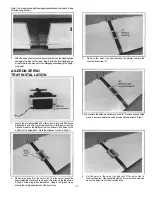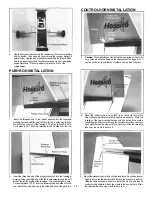
YOUR FIRST FLIGHT
Pre-Flight Checklist
Before leaving for the flying field go through the pre-flight checklist
This will help prevent you from forgetting to take things with you.
A. Make sure the transmitter and receiver battery packs are fully
charged. One way to check is by using a Hobbico voltmeter.
B. Transmitter, make sure it is the same frequency as the receiver.
C. Glow plug clip and fully charged 1 1/2 volt battery.
D. Fuel and fuel pump or fuel bulb.
E. Rubber bands #64.
F. Extra props.
G. Screw driver and knife.
H. Epoxy and something to mix it on.
I. Paper towels (to clean the plane).
FLIGHT DIRECTIONS
Before starting the engine check and make sure all screws are tight, that
the hinges have not come loose, the control surfaces move in the right
directions according to your input on the transmitter, and nobody is on
your frequency.
1. Start the engine and set the needle valve following the engine
manufacture's instructions.
2. Hold the plane tightly and move the throttle to full speed. Pick the
plane up and hold it at a 45'-60' nose up for 10-15 seconds. The
engine should run smoothly. If it starts to die the engine is either too
rich or too lean and the needle valve needs readjusting.
3. Taxi the Hobbistar to the end of the runway and point the nose into
the wind.
4. Check that the control surfaces respond to the transmitter commands.
5. Gently advance the throttle to full power.
6. Gently steer the plane left or right as necessary to obtain a straight
take-off.
7. After the plane has gained speed, gently pull back on the elevator
stick. Do not allow the plane to climb too steeply.
8. Keep the wings level and reduce the throttle some to obtain a gentle
climb.
9. To turn, gently move the aileron stick to the side and pull back on the
elevator. If too much aileron is used the plane will bank too steeply.
Make a wide, gentle turn. When the turn is completed, return the
sticks to the center.
10. After the plane passes by you make another wide 180' turn.
11. When learning to fly it is easier to control the plane by facing the
direction the plane is going and looking over your shoulder at it.
12. Fly in a figure eight making left and right turns at the end of
the straights.
13. For the first landing don't worry about landing on the runway, just try
not to hit any objects. Decide where you are going to land and gently
turn into the wind 500-800 feet down wind.
14. When you know you can reach the landing area, reduce the throttle.
You want the plane to gently descend towards the landing area.
Keep the wings level and do not allow the nose to rise. This can
produce a stall (a lack of lift) and the plane will dive steeply.
15. If the plane is going to be short of the landing area apply some
power to reach the landing area. If the plane is too high, apply power
and climb back up to some altitude and set-up to land again. With
practice you will be flying with more confindence and able to make
nice smooth landings on a runway. The only way to become a good
pilot is to practice.
Hobbico Inc. is proudly known as being the nation's number ONE
supplier for ARF type airplane kits. Below are a few of the fine kits
that are available from your dealer.
HCAA2560 - Diabolo
HCAA2570 - Super Chipmunk 40
HCAA2510 - Super Chipmunk 25
-19-
















